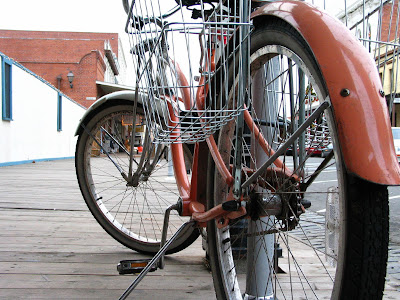From the Sacramento Bee, 02.20.09:
Bike theft is a common crime--no happy ending in most casesLance Armstrong's bike isn't safe from theft. Is yours? The well publicized theft of Armstrong's expensive time trial bike from a locked team truck last weekend in Sacramento has helped generate interest in the very real problem of bike theft. Knowing how to secure your own cherished bicycle is a real key to happy bike commuting. I've been very fortunate--I've had minor accessories stolen, but have never lost a bike. I've always been very conscious about locking, security, and theft deterrence. The following is an excerpt from the relevant chapter of my book, The Bike to Work Guide: What You Need to Know to Save Gas, Go Green, Get Fit
Hey, what about my bike? That's what lots of local cyclists have been saying this week as police worked to crack the Lance Armstrong $10,000-plus bike theft case.
Each year, several thousand bicycles are stolen in the region--and few result in even a token police investigation.
Shawna Sanders, a student at Sacramento City College, said Thursday the lack of any follow-up on her missing bike case "really irritated" her. Sanders...said her old bike was swiped from her backyard near Curtis Park. She carefully secured her new bike's frame to a bike rack with a U-shaped lock. "I understand that they have a lot going on, but … " she said.
Her story isn't unusual, city police officials say, but the reality is there are few leads to work in bike thefts and when budgets are tight, public safety cases win. "Unfortunately, property crimes are not the top priority right now," said Officer Michelle Lazark. (Read more.)
You've arrived at work. Now you need a place to leave your bicycle.
Sadly, employers in the United States are not very enlightened about bicycle parking. They aren't reluctant to provide parking for their employee's automobiles, spending thousands creating a parking lot or garage for staff car parking, and thousands more on lighting, maintaining, security, and insurance for these parking lots. Yet only one automobile parking space could be converted to create parking for ten or more bicycles.
Until your employer gets better informed about the value of staff bicycle parking, you will need to take responsibility for keeping your bicycle secure during the workday...If possible, try to leave your bicycle in a secure indoor location. Not only will this keep your bike secure from thieves, it will also protect it from weather. Perhaps you have enough space in your office to keep your bike there; where it will also become a conversation starter with colleagues and perhaps inspire others at your workplace to bike commute. Perhaps there is a closet or storeroom with space. The luckiest bike commuters work at organizations that provide secure indoor parking.
While regular commuters may want something that provides a bit more security (if it’s available), most cyclists depend on what’s available in the immediate vicinity. Wherever you decide to lock your bike, make sure it’s safe for the bike and safe for everyone else as well. For example, don’t chain your bike in a place where it will block pedestrian’s paths. Besides being obnoxious, it may also be illegal...
Unless you leave your bike at a safe, supervised parking lot, always use a strong bike lock, preferably some sort of U-lock. You may also want to use more than one lock, such as a cable in addition to your U-lock. Redundancy is effective at deterring thieves, who may have the tools to defeat one type of lock, but not several types of lock. And don’t forget to take any accessories or easily removable parts with you when you leave the bike.
Other Theft Deterrence Techniques
• Record your bike's serial number. Every bike has a unique serial number, usually stamped on the frame below the bottom bracket. Record this number in a safe place. If your bike is stolen, report it so that law enforcement agencies could possibly recover your bike.
• Uglify your bike. Make your bike as undesirable as possible. Some cyclists remove brand name decals or repaint the bike to disguise a top-of-the-line model as a piece of junk. Many bicyclists also put decals on their bike, both to express a message ("One Less Car", "I Bike & I Vote" or "What Gas Prices?") and to discourage easy re-sale in the event of theft.
• Use a "beater bike". Leave your expensive titanium or carbon fiber bike at home, commute on a less expensive model. Many bicycle commuters ride "urban beater bikes" that are less appealing to thieves.
• Make it unrideable. Many cyclists remove wheels and saddles to make it impossible for thieves to ride away on a bike. Even thieves who load bikes onto trucks may avoid those with missing parts; they don’t want the hassle of finding spare parts when they can simply steal another bike without missing pieces.
• Register your bike. Many communities offer bicycle registration through the local police department or other agency. Many states or communities also offer or require a bicycle license, which includes an adhesive label. There is also an anti-theft organization, the National Bike Registry, which also provides tamper-proof adhesive label. These discourage thieves, who move on to unregistered bicycles that are more difficult to trace to the original owner.
• Identify your bike. Many bicyclists use permanent markers to personalize their bikes, making them less appealing to bike thieves.
• Report stolen bikes. Most times, police can’t do anything to help you find a stolen bike, especially when it is unregistered. It may be either impossible to find the thief or too time consuming at a busy precinct. However, a large number of stolen bikes are eventually recovered, so it’s worthwhile to report a theft just in case.
• Never buy a stolen bike. Without a thriving market for stolen bikes, the huge problem of bike theft would not exist. Besides, you may be held partly responsible for a theft if you buy a stolen bike. To avoid stolen bikes, only buy from reputable bike shops. If someone offers you a great deal on a used bike, ask to see a receipt or registration. Without either of these, it’s impossible to be sure the bike was'nt stolen at some point.
image: Sacramento Bee.
Visit: What Would Get Americans Biking to Work? Decent Parking., Slate
Visit: Avoiding the Bicycle Thief, Slate Magazine
Visit: A better way to store bikes, Examiner.com
Visit: Theft Prevention, San Francisco Bicycle Coalition
Visit: Bike theft real, and preventable, Bike Commute Tips Blog
Visit: It's 5 p.m., do you know where your bike is?, Bike Commute Tips Blog
Visit: Cutting a bike lock, Bike Commute Tips Blog
Visit: Paul Dorn's Bike Commuting Tips Site




